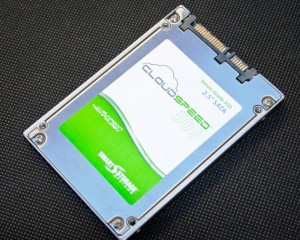 Many organizations implement a “rip and replace” model using cheaper consumer-grade SSDs, and when they inevitably meet their demise under intensive workloads, they’re simply removed and replaced with new drives, increasing the cost of storage.
Many organizations implement a “rip and replace” model using cheaper consumer-grade SSDs, and when they inevitably meet their demise under intensive workloads, they’re simply removed and replaced with new drives, increasing the cost of storage.
Instead of moving up to much pricier solid state storage options, simply burning though cheaper drives makes more financial sense.
SMART Storage Systems’s new CloudSpeed 500 is aimed to fill that gap with a “just right” combination of 3x the endurance of consumer drives at an attractive price.
INTRODUCTION
We’ve already looked at SMART’s Optimus, a drive offered in 10, 25, and 50 drive-writes-per-day flavors to hold down the near-SLC endurance market. While a fraction of the price of SLC drives, the Optimus line is still overkill for many applications, meaning something else is required. In keeping with the SMART philosophy of selling the right amount of endurance for the job, another model is needed to satisfy lower cost and lower endurance requirements. For that, SMART has introduced a new SSD, the SMART Storage Systems CloudSpeed 500 SATA 3 Server Grade SSD. With it, SMART hopes to make a compelling argument for buying just the right amount of endurance and performance at just the right price.
The CloudSpeed 500 will ship in 120GB, 240GB, and 480GB versions based on LSI SandForce silicon. While SMART is reluctant to discuss CloudSpeed pricing, it is reasonable to expect close-to-consumer cost per GB, halfway between 1$ and 2$.
We have the 240GB on our bench, but all three capacities are graced with the same performance specificationss; 60,ooo read IOPS, 20,000 write IOPS, and up to 500MB/s sequential throughput. Performance isn’t the CloudSpeed’s calling card, though, with garden variety consumer-grade flash bumped up to 15K PE cycles, power-loss-protection, and a five year warranty, longevity and reliability is a higher priority.
COMPONENTS
The CloudSpeed’s chassis is well-machined, with a stainless-steel insert serving as the top, all in a fashionable 7mm z-height. Half of the top-plate is applied with a thermal pad for the controller and nearby components. These types of thermal pads are more common now, and while not strictly necessary, it’s good to see. Heat could become an issue in high-density deployments, though the CS500 is spec’d for up to 70c internal temps.
The PCB itself is home to a few surprises too, but the controller isn’t one of them. We’re no stranger to the LSI SandForce SF-2581, as it s the enterprise variant of the SF-2281 flash storage processor that’s become the most popular choice for drive manufacturers of every persuasion. The enterprise version is much the same as it’s consumer-oriented brethren, but includes a few important features that distinguish it from it’s more common family members.
The SF-2581 adds extended S.M.A.R.T information and power-loss-protection support in addition to the standard goodies: R.A.I.S.E. sacrifices some capacity for redundancy in case of a NAND failure, and 24 bits per sector ECC is present. SMART also claims fewer than one uncorrectable error per 10^18 bits read which is far better than JEDEC enterprise SSD spec of 10^16.
SMART’s PCB houses half the the 256GB of flash on the front, with 224GB available capacity. The rest is used for spare area, R.A.I.S.E., and other SF needs, with 7% for over provisioning. Unexpectedly, this flash is branded with SMART Storage Systems’s logo, not the actual flash manufacturer. Unfortunately, it makes identifying the flash’s origins and specifics more difficult. Despite that, much of what we need to know is still clear even with the re-branding.
Either way, it’s still just regular consumer MLC. When SMART gets a batch of NAND, it gets tested, sorted, poked and prodded, and possibly re-programmed as part of their proprietary NAND characterization process. That’s in part how SMART extends their flash’s P/E cycle rating up to 15,000 from a more pedestrian 3,000. The CloudSpeed can recover in the event of a NAND failure, but having consistently good flash is important for achieving higher endurance.
On the back, we see the other 128GB of flash and the nine capacitors to provide power-loss-protection (in addition to spaces for more were they needed for more power-hungry drives). Originally, first and second gen SF drives with power-loss-protection (PLP) used a single supercapacitor to keep the drive powered long enough to finish outstanding writes in the event of a sudden system power failure. That single supercap represents a single point of failure and adds a hefty bit to the bill of materials, which in part explains it’s increasing rarity. Today, most PLP systems are composed of several smaller capacitors.
 The SSD Review The Worlds Dedicated SSD Education and Review Resource |
The SSD Review The Worlds Dedicated SSD Education and Review Resource | 
